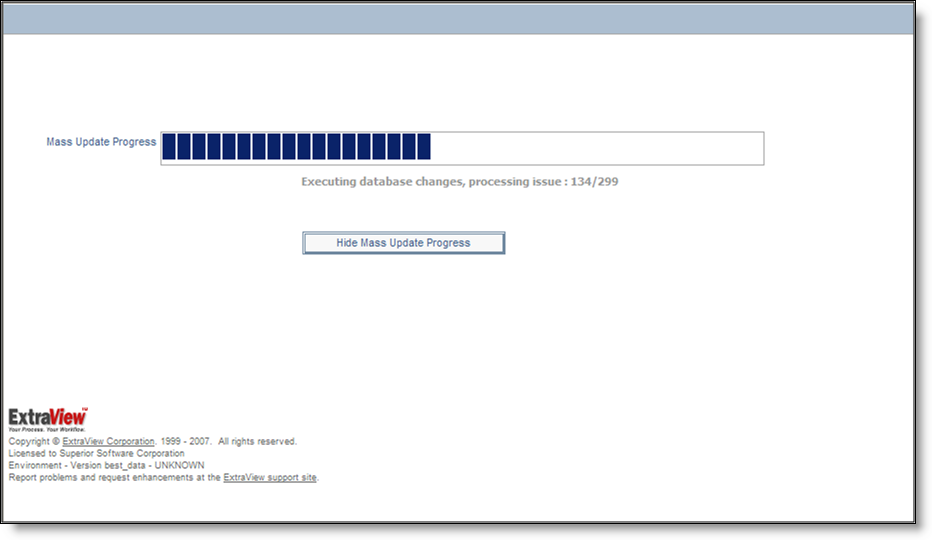It is not recommended that you give end users access to this facility, as it allows the mass update of issues. One wrong update could affect hundreds or thousands of issues and may be very difficult or impossible to undo. This function is most frequently used for tasks such as:
Access to this feature is controlled by the security key named PR_RESOLUTION.MASS_UPDATE_ISSUES.
Assuming the permission is set to be able to use this feature, there will be a button labeled Update on Quicklist Reports, Detailed Reports and Custom Reports that you generate. This button allows the batch or mass update of a list of fields available to you.
Not all fields can be updated by this method. Only fields to which you have write access, and fields that are of display type List, Pop-up, Tab, Checkbox, Log Area, Text, Currency, Number, Decimal, Date, Day and User can be updated. The fields that are offered for update are those that exist on the edit layout in the current business area and project. You cannot update any field outside your current business area and project. However, if your query that selected the field to mass update contains records in other business areas and/or projects, then these will be updated, assuming the field is on the edit layout of the specific area / project.
The execution of mass updates is a background process within ExtraView. Once started, the process cannot be interrupted. This provides several advantages, in that ExtraView will prevent several mass update operations happening concurrently (this may lead to data integrity problems, and the corruption of data) and it gives a significant amount of insulation from problems such as a disruption of the communications network or the client computer crashing midway through the process. To use this feature:
 button to add an additional field to the update process. If you want to remove a field, you can use the
button to add an additional field to the update process. If you want to remove a field, you can use the  button that appears on the second and subsequent fields
button that appears on the second and subsequent fieldsNote the following when using Mass Update:
This shows how you can reassign all open issues from one person to another, for a given product: Prepare a Quicklist report that uses Product, Assigned To and Status as filters. From the resulting report output, press the Update button. You will see a screen similar to:

Selecting a field to update
Select the Assigned To field from the list and the screen will redisplay, showing something similar to:

Mass update screen
From the select list labeled New Value for Assigned To, select the person you want to reassign the issues to. You can view any of the issues to check whether they should be part of the update, and you can uncheck any of the issues. You can also add one or more fields to the mass update by pressing the  button.
button.
If the field you are trying to update is dependent upon another field (for example a module field may be dependent upon product), then you will be prompted for the parent field, then the child field, to ensure that the relationships between the values are kept intact and only valid combinations are stored.
If you try to update a parent field that would invalidate the child records, for example trying to set the product field to a value that is not appropriate for a given module, you will receive an error for that issue, or issues, and these issues will not be updated.
When ready, you can press the Update all records button.
You will be asked to confirm that you want to update the issues.
The default is that email notification is not sent when performing a mass update of issues. However, you can turn this on, by clicking the Generate Email checkbox to on.
On the screen, there is a checkbox that allows you to alter the mass update capability to a mass clone utility. When you check this, you will see that you can select a new business area and a new project. When you perform the update, the issues are copied to the new project, rather than updated. When you undertake this function, you are asked to confirm the operation before it proceeds. See the next section of this guide for more details.
While the mass update is underway, you will see a progress window as follows:

Mass update progress bar
Note: Pressing the button to hide the progress bar, or closing the window has no effect on the execution of the mass update. As a background process, it will continue. The progress bar is purely for informative purposes. Once the mass update is complete, and assuming you have not closed the progress window, you will see a summary of the mass update, including any errors encountered. The most common error is trying to perform a global mass update across several business areas, when the field you are trying to update is not on the edit screen for the business area and project to which the issue belongs.

Results of a mass update, showing errors